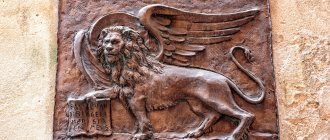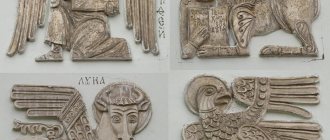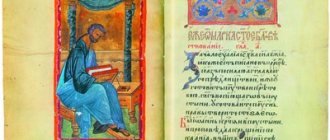Read the Gospel of Mark.
The Gospel of Mark consists of 16 chapters:
Mark's poetic style is expressive and spontaneous. The Gospel is written in Greek. The language of the Gospel is not literary, but closer to colloquial.
Authorship. In the text of this Gospel, as in the texts of other Gospels, there is no indication of authorship. According to church tradition, the authorship is attributed to the disciple of the Apostle Peter, Mark. It is believed that the Gospel was written by Mark based on the memories of Peter.
The Gospel describes an episode about an unknown young man who ran out into the street on the night of the capture of Christ wearing only a blanket. It is believed that this young man was the Evangelist John Mark.
Many modern biblical scholars believe that the Gospel of Mark was the first of the canonical Gospels to be created and, together with the unknown source Q, served as the basis for the writing of the Gospels of Matthew and Luke.
Time of creation. The most likely time for the creation of the Gospel of Mark is the 60-70s. There are two versions of the place of writing - Rome and Alexandria.
Some features.
A number of features distinguish the Gospel of Mark from all other Gospels (and this is in addition to what has already been mentioned). First of all, Mark draws attention more to the actions and deeds of Christ than to His teaching. He describes 18 miracles He performed and conveys only four of the parables He told (4:2-20,26-29,30-32; 12:1-9) and only the main one of His conversations (13:3-37). Mark repeatedly mentions that Jesus taught the people, but does not write what exactly He taught (1:21,39; 2:2,13; 6:2,6,34; 10:1; 12:35).
Most of what he cites from the teachings of Jesus Christ relates to His discussions with the religious leaders of the Jews (2:8-11,19-22,25-28; 3:23-30; 7:6-23; 10:2-12; 12:10-11,13-40). Second, Mark's narrative has a special conviction and a vividness to his style (as already noted), and this reflects the specific source he relied on, the eyewitness testimony of Peter (e.g., 2:4; 4: 37-38; 5:2-5; 6:39; 7:33; 8:23-24; 14:54).
The Greek language of this evangelist is not literary, but colloquial, which was used at that time for everyday communication, and the influence and “flavor” of Semitic speech are felt in it. Mark is characterized by: unique use of Greek tense forms, especially the so-called “historical present” (used by him more than 150 times); simple sentences connected by the conjunction “and”; frequent use of the word “immediately” (euthys; commentary on 1:10); as well as the use of “strong” words and expressions (for example, in 1:12, where it would be more correct to translate “drives” rather than “leads”).
Thirdly, Mark has amazing directness and sincerity in presenting material. His listeners of Jesus react emotionally to everything. They are “amazed,” “horrified,” etc. (commentary on 1:22,27; 2:12; 5:20; 9:15). Mark mentions the concern of those close to Jesus Christ about His mental health (3:21,31-35). He repeatedly and frankly notes that the disciples often did not understand Jesus (4:13; 6:52; 8:17,21; 9:10,32; 10:26).
He speaks emphatically about the feelings that possessed Christ: about His inherent compassion for people (1:41; 6:34; 8:2; 10:16), about His anger and grief (1:43; 3:5; 8:33 ; 10:14), about His longing and longing (7:34; 8:12; 14:33-34). Fourth, the dominant theme of Mark's Gospel is Jesus' journey from the Cross to the Resurrection.
From 8:31 onwards, He and the disciples are described as traveling along the roads of Galilee (9:33 and 10:32) from Caesarea Philippi in the north to Jerusalem in the south. The final part of this Gospel (36% of its text) is devoted to the events that took place during Holy Week - in those eight days that separated the Lord’s triumphal entry into Jerusalem (11:1-11) from His resurrection (16:1-8).
Interpretation of the Gospel of Mark.
Most of the testimonies of the Church Fathers that have survived to our times claim that the Gospel of Mark was created in Rome and was intended primarily for pagan Christians. This is evidenced by a number of facts:
- Explanations of Jewish customs,
- Translation of Aramaic expressions into understandable Greek.
- Use of a large number of Latinisms.
- Using the time system used in Rome.
- A small number of quotations from the Old Testament.
- The Lord's concern for “all nations” is emphasized
Evangelist Mark is more attracted by the actions than by the speeches of Christ (18 miracles are described and only 4 parables).
It was important for Mark to emphasize that Jesus was unwilling to reveal himself as the Messiah until His followers understood the nature of His Messiahship and the true nature of His ministry.
In the Gospel, Jesus calls Himself the Son of Man 12 times and Christ (Messiah) only once. This is explained by the fact that the messianic task itself - to be a servant of Jehovah and to give his life for people according to His will - better corresponded to the hypostasis of the Son of Man
It was difficult for Christ's disciples to understand His plan - they expected a triumphant Messiah, and not the One who would suffer and die for the sins of mankind. The apostles are afraid and do not understand what awaits them. That is why they fled when the soldiers grabbed Jesus.
With special feeling, Mark writes about the angel's news that Christ has risen and will meet with his disciples in Galilee. The point of the ending is that Jesus is alive and will lead and care for his followers.
Purposes of the Gospel of Mark:
- describe the life of Christ as the servant of God;
- attract new followers to the Christian faith;
- to instruct and strengthen new Christian converts in the faith in the face of the persecution that awaited them
The main purpose of the gospel is to deeply understand the meaning of discipleship and following Christ in the context of His death and resurrection.
Author.
The early Church Fathers are unanimous that he was Mark, a colleague of Peter. The earliest evidence comes from Papias (ca. 110), who in turn referred to "Elder John" (most likely meaning John the Evangelist). Papias calls Mark the author of this Gospel and gives the following information about him: 1) He was not a direct witness to the ministry of Jesus Christ. 2) He accompanied the Apostle Peter and heard his sermons. 3) He carefully wrote down the words of Jesus, as Peter remembered them, and those deeds of the Lord that were remembered by this apostle - however, not in order, notes Papias, that is, not always in chronological sequence. 4) Mark was Peter's "interpreter", that is, he apparently wrote down what Peter taught and explained his teaching to a wider circle of listeners. 5) His story is completely reliable.
Earlier evidence for Mark's authorship was subsequently confirmed by Justin Martyr (Dialogue, about 160 AD, etc.), Irenaeus (Against Heresies, about 180 AD), Clement Alexandria (about 195) and Origen (about 230), the latter two being referred to by Eusebius in his History of the Church. Thus, the “external evidence” is quite early and comes from various centers of the initial spread of Christianity, such as Alexandria, Asia Minor and Rome.
Most interpreters of the Holy Scriptures believe that the Hebrew name of the Evangelist Mark was “John,” i.e., that we are talking about John Mark. There are 10 references to his Latin name - “Mark” in the New Testament (Acts 12:12,25; 13:5,13; 15:37,39; Col. 4:10; 2 Tim. 4:11; Philim 1:24; 1 Pet. 5:13). The existing objections to the idea that Mark and John are the same person do not sound convincing. Because nothing is known from the New Testament about any “other” Mark who had a close relationship with Peter.
“Internal evidence,” although not always and not in everything, corresponds to historical evidence from the early Christian Church. The following information can be gleaned from both sources: 1) Mark was well acquainted with the “geography” of Palestine, and especially with Jerusalem (Mark 5:1; 6:53; 8:10; 11:1; 13:3). 2) He knew the Aramaic language, which was then spoken in Palestine (5:41; 7:11,34; 14:36). 3) He understood Jewish institutions and customs (1:21; 2:14,16,18; 7:2-4).
Several points seem to indicate the “closeness” of the author of this Gospel to the Apostle Peter: a) The liveliness of the story and the presence of a number of details in it indicate that the source of this record were the memories of someone who, like Peter, belonged to a narrow apostolic circle of witnesses of what happened (1:16-20,29-31,35-38; 5:21-24,35-43; 6:39,53-54; 8:14-15; 10:32, 46; 14: 32-42); b) The author’s references to the words and deeds of Peter (8:29,32-33; 9:5-6; 10:28-30; 14:29-31,66-72); c) His inclusion of the words “and Peter” in 16:7; d) There is a great similarity between this Gospel in its general outline and Peter's preaching in Caesarea (compare Acts 10:34-43).
In the light of both external and internal evidence, it is legitimate to assert that the “John Mark” spoken of in Acts. The Apostles and in the Epistles is the author of this Gospel. He was a Jewish Christian who lived in his youth with his mother Mary in Jerusalem in the days when the church arose there. Nothing is known about his father. The first Christians gathered in their house (Acts 12:12).
Perhaps it was there that the last Passover supper of Jesus and His disciples took place (commentary on Mark 14:12-16). It is possible that Mark was the young man who ran away naked from the Roman soldiers after they captured Jesus (commentary on 14:51-52). The Apostle Peter calls Mark “my son” (1 Pet. 5:13), and this may mean that he became a Christian under the influence of Peter.
Mark undoubtedly listened to the sermons of this apostle in the Jerusalem church immediately after its establishment (approximately 33-47 AD). Later he went to Antioch with Paul and Barnabas (Mark's uncle - Col. 4:10), but on this first missionary journey he only reached Perga with them (this happened around 48-49; Acts 12:25; 13:5,13). For an unknown reason, Mark returned from there to Jerusalem. Because of this “desertion,” Paul refused to take him with him on his second missionary journey. And Mark went with Barnabas to the island of Cyprus (about 50 -?; Acts 15:36-39).
Later, perhaps around 57, he went to Rome. Mark was Paul's assistant during his first imprisonment in Rome (Col. 4:10; Philim. 1:23-24; this happened around 60-62). After the release of the Apostle Paul, Mark apparently remained in Rome and assisted the Apostle Peter there when he arrived in “Babylon,” as Peter called Rome (1 Pet. 5:13), around 63-64. (Some, however, believe that by “Babylon” Peter actually meant this city on the Euphrates River - an interpretation of 1 Pet. 5:13.) Probably due to the strong persecution of Christians under Emperor Nero and after the martyrdom of Peter Mark left the imperial capital for a while.
We know that during his second imprisonment in Rome (67-68), the Apostle Paul asked Timothy, who was then in Ephesus, but was going to Rome, to bring Mark with him (he, apparently, was then somewhere in Asia Minor and was needed by Paul as an assistant in his ministry; 2 Timothy 4:11).
The fact that Mark is the author of this Gospel does not mean (as follows from the above) that he is an “independent” compiler of the material included in it. The “gospel” is a special type of literature that arose in the first century A.D. It is not simply a biography of Jesus Christ or a description of His “great deeds”, or a record of everything connected with Him as remembered by His followers, although, of course, elements both of these, and the other, and the third are found in the Gospels.
But in general, the Gospel is a proclamation addressed to a specific audience - in the light of theological truths known to that audience - of the Good News, which runs like a “red thread” through the historical events associated with the life, death and resurrection of Christ. This is precisely the meaning and purpose of each of the Gospels. And in accordance with this purpose, Mark selected and arranged the historical material available to him.
So, its main source was the sermons and instructions of the Apostle Peter (interpretation on the section “Authorship”). While listening to them, he may have taken notes. Undoubtedly, Mark also learned something from personal conversations with Peter. In addition, he communicated with Paul and Barnabas (Acts 13:5-12; 15:39; Col. 4:10-11). It can be assumed that Mark included at least one of his own memories in his Gospel (Mark 14:51-52).









